2007 MERCEDES-BENZ C-CLASS ESTATE steering
[x] Cancel search: steeringPage 38 of 377
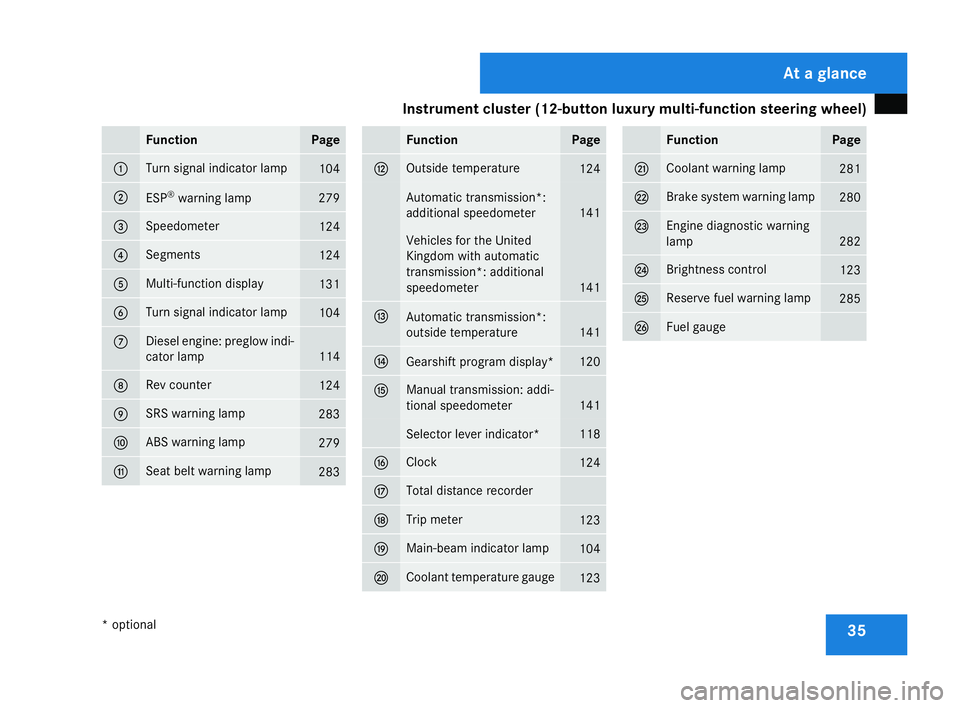
Instrument cluster (12-button luxury multi-function steering wheel)
35Function Page
1 Turn signal indicator lamp
104
2
ESP
®
warning lamp 27
9 3 Speedometer
124
4 Segments
124
5 Multi-function display
131
6 Turn signal indicator lamp
104
7 Diesel engine: preglow indi-
cator lamp
114
8 Rev counter
12
4 9 SRS warning lamp
283
a ABS warning lamp
279
b Seat belt warning lamp
283 Function Pag
e c Outside temperature
124
Automatic transmission*:
additional speedometer
141
Vehicles for the United
Kingdom with automatic
transmission*: additional
speedometer 141
d
Automatic transmission*
:
outside temperature 141
e
Gearshift program display* 12
0 f Manual transmission: addi-
tional speedometer
141
Selector lever indicator* 118
g Cloc
k 124
h Total distance recorder
j Trip meter
123
k Main-beam indicator lamp
104
l Coolant temperature gauge
12
3 Function Pag
e m Coolant warning lamp
28
1 n Brake system warning lamp
280
o Engine diagnostic warning
lamp 282
p Brightness control
123
q Reserve fuel warning lamp
28
5 r Fuel gaug
e At a glance
* optional
204_AKB; 2; 3, en-G
B
mkalafa , 2007-06-26T23:11:51+02:00 - Seite 35
Page 39 of 377
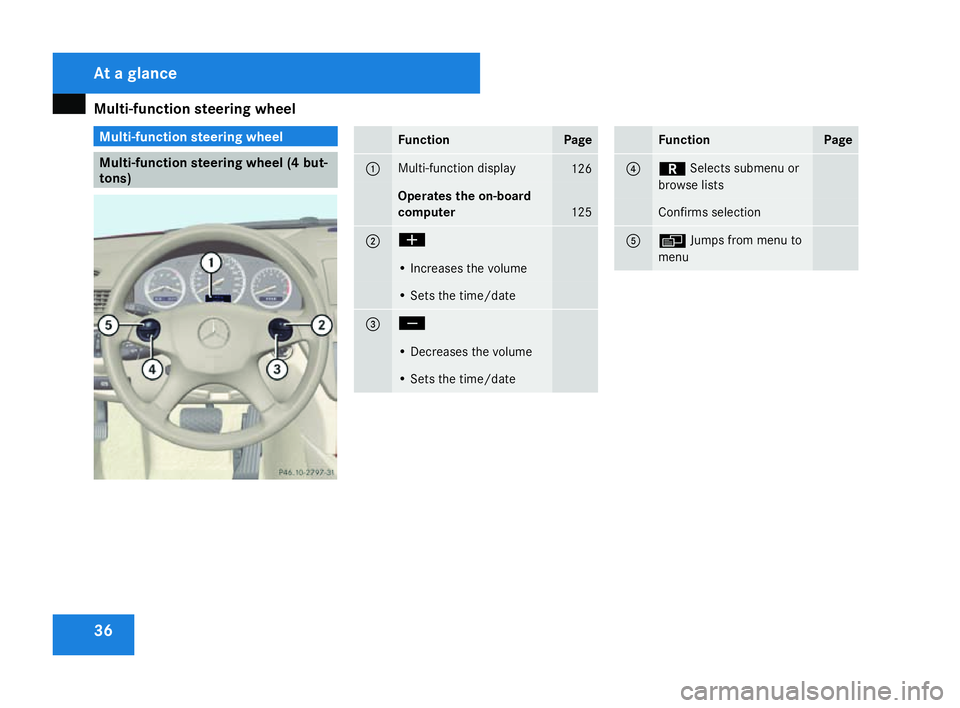
Multi-function steering wheel
36 Multi-function steering wheel
Multi-function steering wheel (4 but-
tons) Function Page
1 Multi-function display
126
Operates the on-board
computer 125
2 æ
• Increases the volume
• Sets the time/dat
e 3 ç
• Decreases the volume
• Sets the time/dat
e Function Pag
e 4 í
Selects submenu or
browse lists Confirms selection
5 è
Jumps from menu to
men u At a glance
204_AKB; 2; 3, en-G
B
mkalafa , 2007-06-26T23:11:51+02:00 - Seite 36
Page 40 of 377
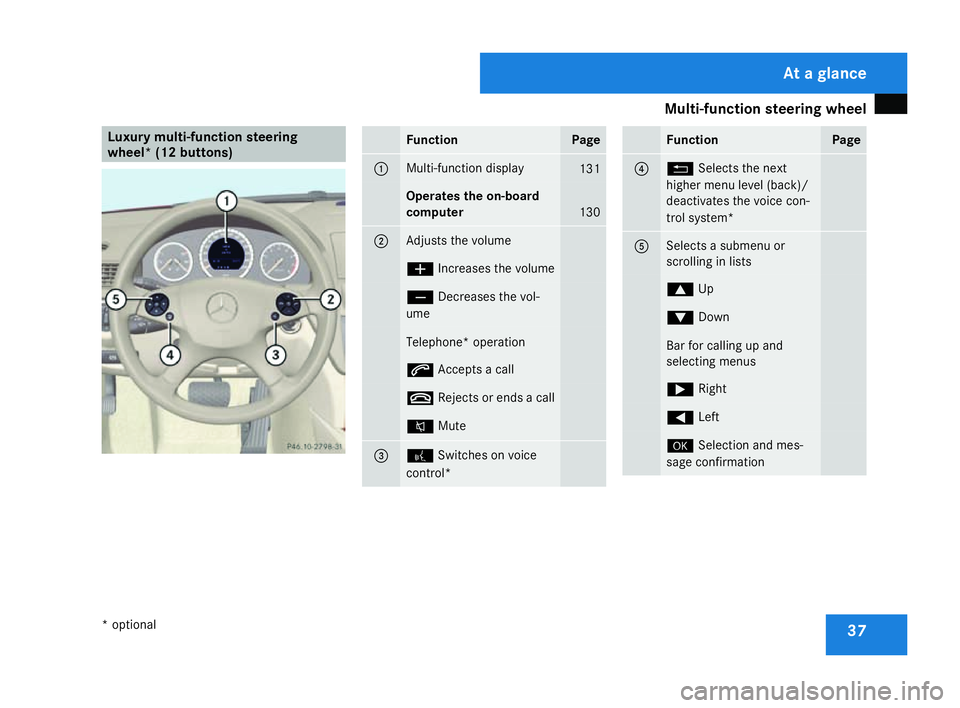
Multi-function steering wheel
37Luxury multi-function steering
wheel* (12 buttons)
Function Page
1 Multi-function display
131
Operates the on-board
computer
130
2 Adjusts the volum
e æ
Increases the volume ç
Decreases the vol -
ume Telephone* operation
s
Accepts a cal l t
Rejects or ends a call F
Mute 3 !
Switches on voice
control * Function Pag
e 4 L
Selects the next
higher menu level (back) /
deactivates the voice con -
trol system* 5 Selects a submenu or
scrolling in lists
$
Up %
Down Bar for calling up and
selecting menu
s &
Right (
Left #
Selection and mes -
sage confirmation At a glance
* optional
204_AKB; 2; 3, en-GB
mkalafa,
2007-06-26T23:11:51+02:00 - Seite 37
Page 49 of 377
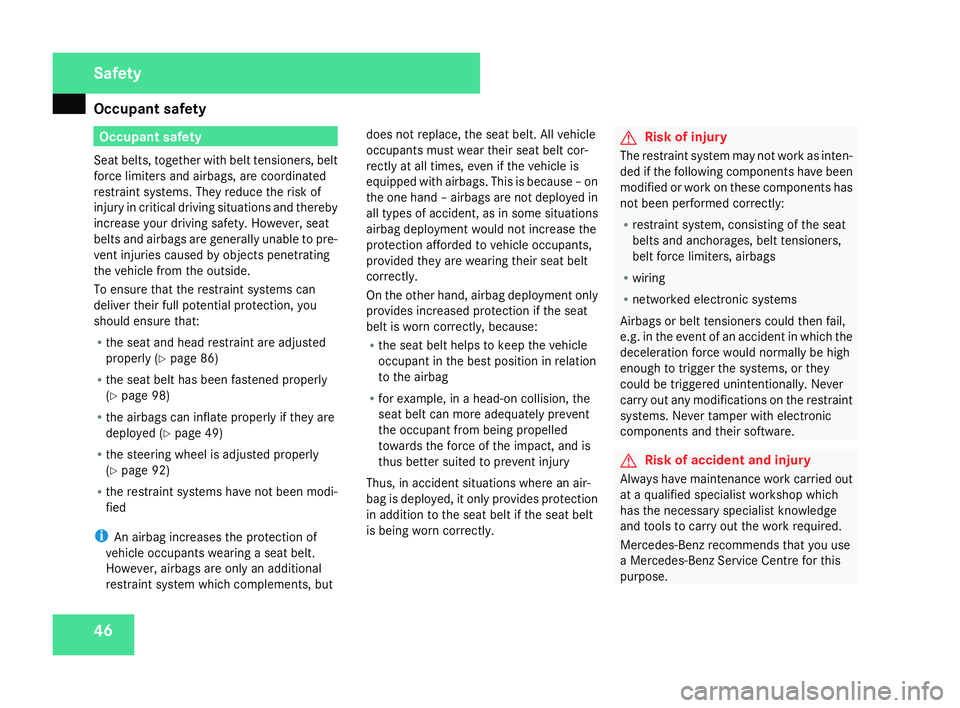
Occupant safet
y46 Occupant safet
y
Seat belts, together with belt tensioners, belt
force limiters and airbags, are coordinate d
restraint systems. They reduce the risk of
injury in critical driving situations and thereby
increase your driving safety. However, seat
belts and airbags are generally unable to pre-
vent injuries caused by objects penetrating
the vehicle from the outside.
To ensure that the restraint systems can
deliver their full potential protection, you
should ensure that:
R the seat and head restraint are adjusted
properly (Y page 86)
R the seat belt has been fastened properl y
( Y page 98)
R the airbags can inflate properly if they ar e
deployed (Y page 49)
R the steering wheel is adjusted properl y
( Y page 92)
R the restraint systems have not been modi-
fied
i An airbag increases the protection of
vehicle occupants wearing a seat belt.
However, airbags are only an additional
restraint system which complements, bu tdoes not replace, the seat belt. All vehicle
occupants must wear their seat belt cor-
rectly at all times, even if the vehicle is
equipped with airbags. This is because – on
the one hand – airbags are not deployed in
all types of accident, as in some situation
s
airbag deployment would not increase th e
protection afforded to vehicle occupants,
provided they are wearing their seat belt
correctly.
On the other hand, airbag deployment only
provides increased protection if the seat
belt is worn correctly, because:
R the seat belt helps to keep the vehicl e
occupant in the best position in relation
to the airbag
R for example, in a head-on collision, the
seat belt can more adequately prevent
the occupant from being propelle d
towards the force of the impact, and is
thus better suited to prevent injury
Thus, in accident situations where an air-
bag is deployed, it only provides protection
in addition to the seat belt if the seat belt
is being worn correctly. G
Risk of injury
The restraint system may not work as inten-
ded if the following components have bee n
modified or work on these components has
not been performed correctly:
R restraint system, consisting of the seat
belts and anchorages, belt tensioners,
belt force limiters, airbags
R wirin g
R networked electronic system s
Airbags or belt tensioners could then fail ,
e.g. in the event of an accident in which the
deceleration force would normally be high
enough to trigger the systems, or they
could be triggered unintentionally. Never
carry out any modifications on the restraint
systems. Never tamper with electronic
components and their software. G
Risk of accident and injury
Always have maintenance work carried ou t
at a qualified specialist workshop whic h
has the necessary specialist knowledge
and tools to carry out the work required.
Mercedes-Benz recommends that you use
a Mercedes-Benz Service Centre for this
purpose. Safety
204_AKB; 2; 3, en-GB
mkalafa,
2007-06-26T23:11:51+02:00 - Seite 46
Page 53 of 377
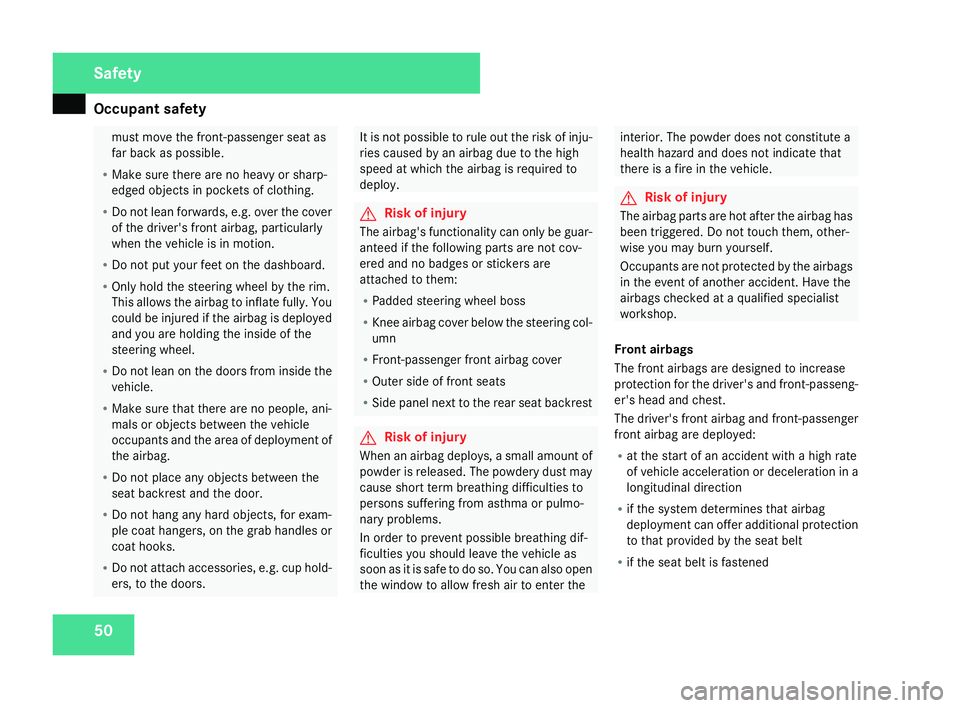
Occupant safet
y50 must move the front-passenger seat as
far back as possible.
R Make sure there are no heavy or sharp-
edged objects in pockets of clothing.
R Do not lean forwards, e.g. over the cove r
of the driver's front airbag, particularly
when the vehicle is in motion .
R Do not put your feet on the dashboard.
R Only hold the steering wheel by the rim.
This allows the airbag to inflate fully. You
could be injured if the airbag is deployed
and you are holding the inside of the
steering wheel.
R Do not lean on the doors from inside the
vehicle.
R Make sure that there are no people, ani-
mals or objects between the vehicle
occupants and the area of deployment of
the airbag.
R Do not place any objects between the
seat backrest and the door.
R Do not hang any hard objects, for exam-
ple coat hangers, on the grab handles or
coat hooks .
R Do not attach accessories, e.g. cup hold -
ers, to the doors. It is not possible to rule out the risk of inju-
ries caused by an airbag due to the high
speed at which the airbag is required to
deploy.
G
Risk of injury
The airbag's functionality can only be guar-
anteed if the following parts are not cov-
ered and no badges or stickers are
attached to them:
R Padded steering wheel boss
R Knee airbag cover below the steering col-
umn
R Front-passenger front airbag cover
R Outer side of front seats
R Side panel next to the rear seat backres t G
Risk of injury
When an airbag deploys, a small amount of
powder is released. The powdery dust may
cause short term breathing difficulties to
persons suffering from asthma or pulmo -
nary problems .
In order to prevent possible breathing dif-
ficulties you should leave the vehicle as
soon as it is safe to do so. You can also open
the window to allow fresh air to enter the interior. The powder does not constitute
a
health hazard and does not indicate that
there is a fire in the vehicle. G
Risk of injury
The airbag parts are hot after the airbag ha s
been triggered. Do not touch them, other -
wise you may burn yourself.
Occupants are not protected by the airbags
in the event of another accident. Have th e
airbags checked at a qualified specialist
workshop.
Front airbag s
The front airbags are designed to increase
protection for the driver's and front-passeng-
er's head and chest .
The driver's front airbag and front-passenger
front airbag are deployed:
R at the start of an accident with a high rat e
of vehicle acceleration or deceleration in a
longitudinal direction
R if the system determines that airbag
deployment can offer additional protection
to that provided by the seat belt
R if the seat belt is fastened Safety
204_AKB; 2; 3, en-GB
mkalafa,
2007-06-26T23:11:51+02:00 - Seite 50
Page 54 of 377
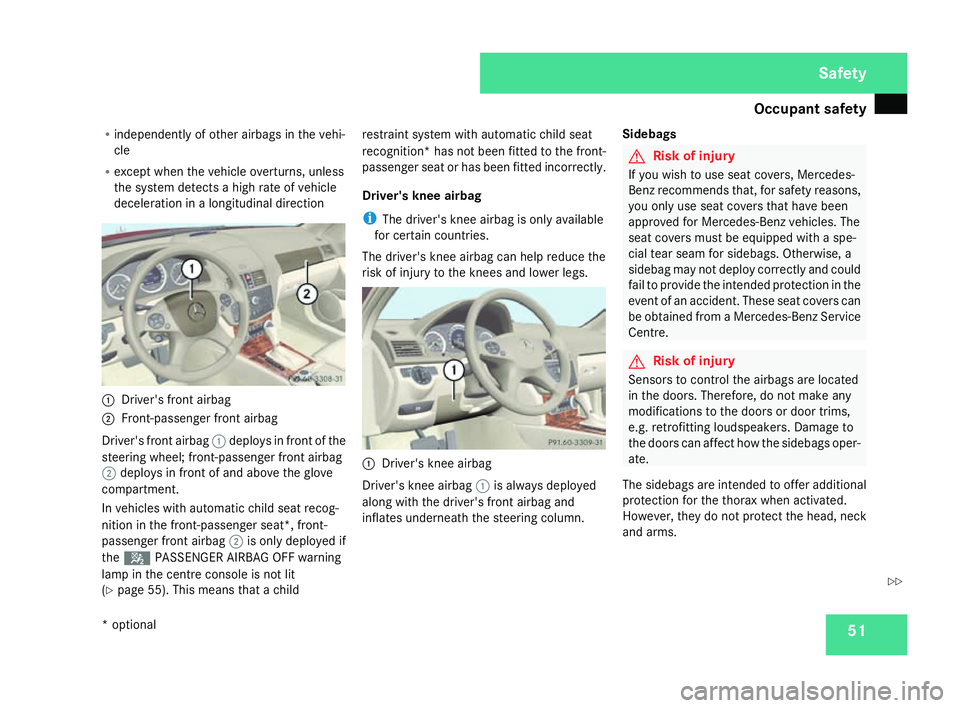
Occupant safet
y 51
R
independently of other airbags in the vehi-
cle
R except when the vehicle overturns, unless
the system detects a high rate of vehicle
deceleration in a longitudinal direction 1
Driver's front airba g
2 Front-passenger front airba g
Driver's front airbag 1deploys in front of the
steering wheel; front-passenger front airbag
2 deploys in front of and above the glove
compartment .
In vehicles with automatic child seat recog-
nition in the front-passenger seat*, front-
passenger front airbag 2is only deployed if
the 5 PASSENGER AIRBAG OFF warning
lamp in the centre console is not lit
( Y page 55). This means that a child restraint system with automatic child seat
recognition* has not been fitted to the front-
passenger seat or has been fitted incorrectly.
Driver's knee airba
g
i The driver's knee airbag is only available
for certain countries.
The driver's knee airbag can help reduce the
risk of injury to the knees and lower legs. 1
Driver's knee airba g
Driver's knee airbag 1is always deployed
along with the driver's front airbag and
inflates underneath the steering column. Sidebags G
Risk of injury
If you wish to use seat covers, Mercedes-
Benz recommends that, for safety reasons ,
you only use seat covers that have been
approved for Mercedes-Benz vehicles. The
seat covers must be equipped with a spe -
cial tear seam for sidebags. Otherwise, a
sidebag may not deploy correctly and could
fail to provide the intended protection in the
event of an accident. These seat covers can
be obtained from a Mercedes-Benz Service
Centre. G
Risk of injury
Sensors to control the airbags are locate d
in the doors. Therefore, do not make any
modifications to the doors or door trims,
e.g. retrofitting loudspeakers. Damage to
the doors can affect how the sidebags oper-
ate.
The sidebags are intended to offer additional
protection for the thorax when activated.
However, they do not protect the head, nec k
and arms. Safety
* optional
204_AKB; 2; 3, en-GB
mkalafa
, 2007-06-26T23:11:51+02:00 - Seite 51 Z
Page 70 of 377
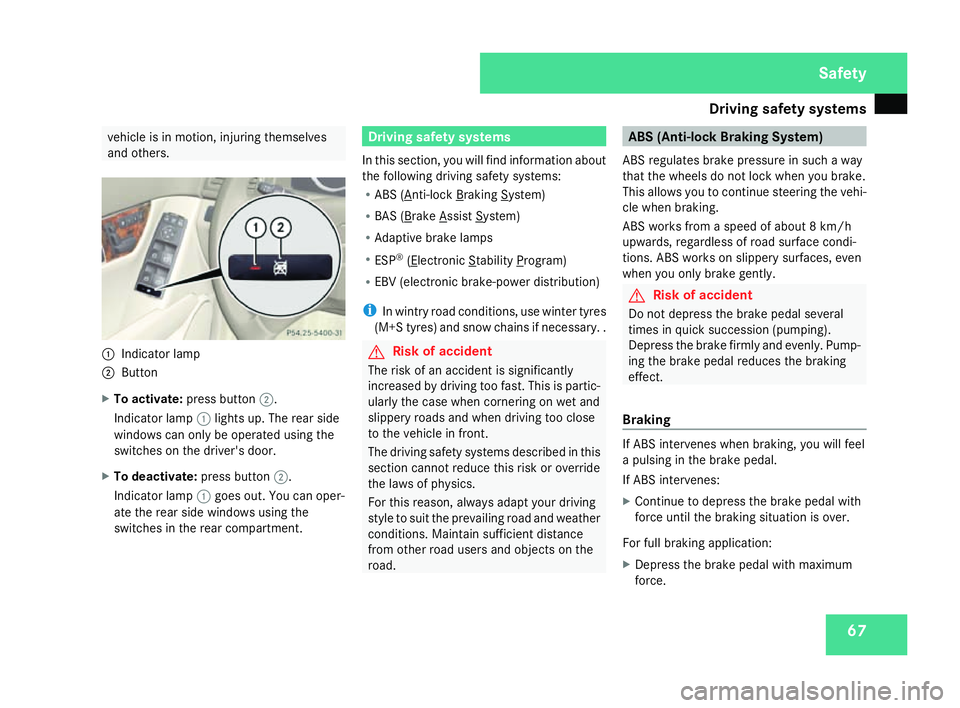
Driving safety sys
tems 67vehicle is in motion, injuring themselves
and others . 1
Indicator lamp
2 Button
X To activate :press button 2.
Indicator lamp 1lights up. The rear side
windows can only be operated using the
switches on the driver's door.
X To deactivate :press button 2.
Indicator lamp 1goes out. You can oper-
ate the rear side windows using the
switches in the rear compartment. Driving safety systems
In this section, you will find information about
the following driving safety systems:
R ABS ( Anti-lock Braking System)
R BAS ( Brake Assist System)
R Adaptive brake lamps
R ESP ®
( Electronic Stability Program)
R EBV (electronic brake-power distribution)
i In wintry road conditions, use winter tyres
(M+S tyres) and snow chains if necessary. . G
Risk of accident
The risk of an accident is significantl y
increased by driving too fast. This is partic-
ularly the case when cornering on wet and
slippery roads and when driving too clos e
to the vehicle in front.
The driving safety systems described in thi s
section cannot reduce this risk or override
the laws of physics.
For this reason, always adapt your driving
style to suit the prevailing road and weather
conditions. Maintain sufficient distance
from other road users and objects on the
road. ABS (Anti-lock Braking System)
ABS regulates brake pressure in such a way
that the wheels do not lock when you brake.
This allows you to continue steering the vehi-
cle when braking.
ABS works from a speed of about 8 km/h
upwards, regardless of road surface condi-
tions. ABS works on slippery surfaces, even
when you only brake gently. G
Risk of accident
Do not depress the brake pedal severa l
times in quick succession (pumping) .
Depress the brake firmly and evenly. Pump-
ing the brake pedal reduces the braking
effect.
Braking If ABS intervenes when braking, you will fee
l
a pulsing in the brake pedal.
If ABS intervenes:
X Continue to depress the brake pedal wit h
force until the braking situation is over.
For full braking application:
X Depress the brake pedal with maximum
force. Safety
204_AKB; 2; 3, en-G
B
mkalafa , 2007-06-26T23:11:51+02:00 - Seite 67
Page 78 of 377
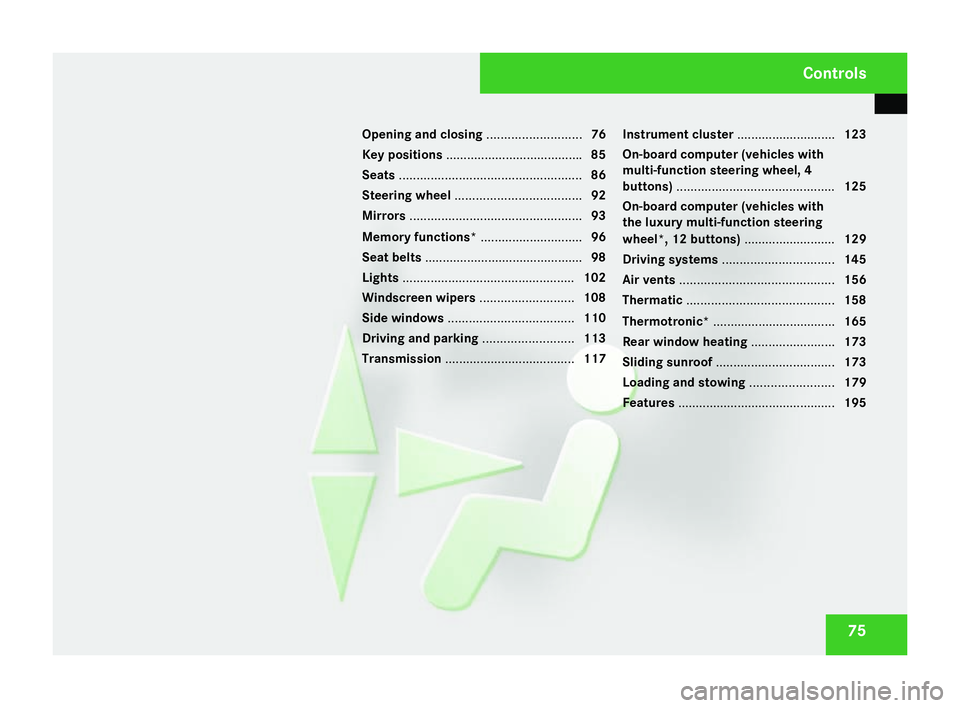
75
Opening and closing
...........................76
Key positions ...................................... .85
Seats .................................................... 86
Steering wheel .................................... 92
Mirrors ................................................. 93
Memory functions* .............................96
Seat belts ............................................ .98
Lights ................................................. 102
Windscreen wipers ...........................108
Side windows .................................... 110
Driving and parking ..........................113
Transmission ..................................... 117Instrument cluster
............................123
On-board computer (vehicles with
multi-function steering wheel, 4
buttons) ............................................. 125
On-board computer (vehicles with
the luxury multi-function steering
wheel*, 12 buttons) ..........................129
Driving systems ................................ 145
Air vents ............................................ 156
Thermatic .......................................... 158
Thermotronic* ................................... 165
Rear window heating ........................173
Sliding sunroof .................................. 173
Loading and stowing ........................179
Features ............................................. 195 Controls
204_AKB; 2; 3, en-GB
mkalafa,
2007-06-26T23:11:51+02:00 - Seite 75